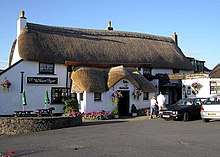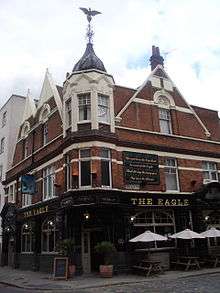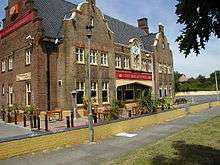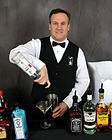Pub
A pub, or public house, is an establishment licensed to serve alcoholic drinks for consumption on the premises. The term public house first appeared in the late 17th century, and was used to differentiate private houses from those which were, quite literally, open to the public as 'alehouses', 'taverns' and 'inns'. By Georgian times it had become common parlance, although taverns, as a distinct establishment, had largely ceased to exist by the beginning of the 19th century.[1] Today, pubs have no strict definition, but CAMRA states a pub has four characteristics:[2]
- is open to the public without membership or residency
- serves draught beer or cider without requiring food be consumed
- has at least one indoor area not laid out for meals
- allows drinks to be bought at a bar (i.e., not only table service)
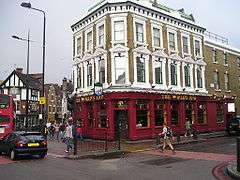
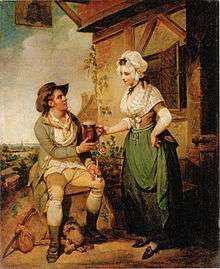
The history of pubs can be traced to Roman taverns in Britain,[3][4] and through Anglo-Saxon alehouses, but it was not until the early 19th century that pubs, as we know them today, first began to appear. The model also became popular in countries and regions of British influence, where pubs are often still considered to be an important aspect of their culture.[5][6][7] In many places, especially in villages, pubs are the focal point of local communities. In his 17th-century diary, Samuel Pepys described the pub as "the heart of England".[8] Although the drinks traditionally served include draught beer and cider, most also sell wine, spirits, coffee, and soft drinks. Many also offer meals and snacks.
A licence is required to operate a pub and the licensee is known as the landlord or landlady, or the publican. Often colloquially referred to as their "local" by regulars,[9] pubs are typically chosen for their proximity to home or work, good food, social atmosphere, the presence of friends and acquaintances, and the availability of pub games such as darts or snooker. Pubs often screen sporting events, such as rugby and football. The pub quiz was established in the UK in the 1970s.
History
Origins
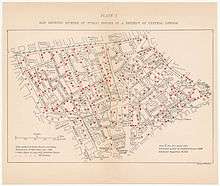
Ale was a native British drink before the arrival of the Roman Empire in 1st century, but it was with the construction of the Roman road network that the first pubs, called tabernae, began to appear. The word eventually became corrupted into tavern.[4]
After the departure of Roman authority in the 5th century and the fall of the Romano-British kingdoms, the Anglo-Saxons established alehouses that may have grown out of domestic dwellings, first attested in the 10th century. These alehouses quickly evolved into meeting houses for folk to socially congregate, gossip and arrange mutual help within their communities. The Wantage law code of Æthelred the Unready proscribes fines for breaching the peace at meetings held in alehouses.[10]
A traveller in the early Middle Ages could obtain overnight accommodation in monasteries, but later a demand for hostelries grew with the popularity of pilgrimages and travel. The Hostellers of London were granted guild status in 1446 and in 1514 the guild became the Worshipful Company of Innholders.[11] A survey in 1577 of drinking establishment in England and Wales for taxation purposes[12] recorded 14,202 alehouses, 1,631 inns, and 329 taverns, representing one pub for every 187 people.[13]
Inns
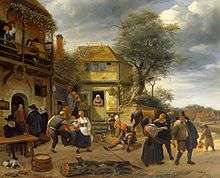
Inns are buildings where travellers can seek lodging and, usually, food and drink. They are typically located in the country or along a highway. In Europe, they possibly first sprang up when the Romans built a system of roads two millennia ago.[14] Some inns in Europe are several centuries old. In addition to providing for the needs of travellers, inns traditionally acted as community gathering places.
In Europe, it is the provision of accommodation,[15] if anything, that now distinguishes inns from taverns, alehouses and pubs. The latter tend to provide alcohol (and, in the UK, soft drinks and often food), but less commonly accommodation. Inns tend to be older and grander establishments: historically they provided not only food and lodging, but also stabling and fodder for the traveller's horse(s) and on some roads fresh horses for the mail coach.
Famous London inns include The George, Southwark and The Tabard. There is, however, no longer a formal distinction between an inn and other kinds of establishment. Many pubs use "Inn" in their name, either because they are long established former coaching inns, or to summon up a particular kind of image, or in many cases simply as a pun on the word "in", as in "The Welcome Inn", the name of many pubs in Scotland.
The original services of an inn are now also available at other establishments, such as hotels, lodges, and motels, which focus more on lodging customers than on other services, although they usually provide meals; pubs, which are primarily alcohol-serving establishments; and restaurants and taverns, which serve food and drink. In North America, the lodging aspect of the word "inn" lives on in hotel brand names like Holiday Inn, and in some state laws that refer to lodging operators as innkeepers.
The Inns of Court and Inns of Chancery in London started as ordinary inns where barristers met to do business, but became institutions of the legal profession in England and Wales.
The 1830 Beerhouse Act
Gin was popularised in England following the accession of William of Orange in 1688, largely because it provided an alternative to French brandy at a time of both political and religious conflict between Britain and France. Between 1689 and 1697 the British Government passed a range of legislation aimed at restricting brandy imports and encouraging domestic gin production.[16] No licenses were required to make spirits and thousands of gin-shops sprang up all over England. Because of its cheapness, gin became popular with the poor, eventually leading to the Gin Craze and by 1727 over half of London's 15,000 drinking establishments were dedicated to gin.[17]
The drunkenness and lawlessness created by gin was seen to lead to the ruination and degradation of the working classes, as illustrated by William Hogarth in his engravings Beer Street and Gin Lane. The Gin Act of 1736 and the Gin Act of 1743 were ineffective attempts to control the situation, but the Gin Act of 1751 proved more successful and succeeded in reducing consumption.[18]
By the early 19th century, encouraged by a reduction of duties, gin houses and gin palaces (an evolution of gin shops) began to spread from London to most towns and cities in Britain and gin consumption again began to rise. Alarmed at the prospect of a return to the Gin Craze, and under a banner of "reducing public drunkenness" the Government attempted to counter the threat by introducing the Beerhouse Act of 1830. The Act introduced a new lower tier of premises, "the beerhouse".
At the time, beer was viewed as harmless and nutritious, even healthy. Young children were often given what was described as small beer, brewed to have a low alcohol content, as the local water was frequently unsafe. Even the evangelical church and temperance movements of the day viewed the drinking of beer very much as a secondary evil and a normal accompaniment to a meal. The beerhouse Act was an attempt to wean drinkers away from the evils of gin and encourage the consumption of a more wholesome beverage.[19]
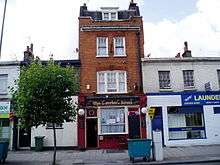
Under the 1830 Act any householder, on payment of two guineas (roughly equal in value to £189 today), was permitted to brew and sell beer or cider in his home. The permission did not extend to the sale of spirits and fortified wines, and any beerhouse discovered selling those items was closed down and the owner heavily fined.[20]
Beerhouses were not permitted to open on Sundays. The beer was usually served in jugs or dispensed directly from tapped wooden barrels on a table in the corner of the room. Often profits were so high the owners were able to buy the house next door to live in, turning every room in their former home into bars and lounges for customers.
In the first year, 400 beer houses opened and within eight years there were 46,000[21] across the country, far outnumbering the combined total of long-established taverns, pubs, inns and hotels. Because it was so easy to obtain permission and the profits could be huge compared to the low cost of gaining permission, the number of beer houses continued to rise; in some towns nearly every other house in a street might be a beerhouse. Finally in 1869 the growth had to be checked by magisterial control. New licensing laws were introduced making it harder to get a licence, and the regime which operates today was established.
Advent of the modern pub
It was not until the 19th century that pubs as we know them today first began to appear.[22] Before this time alehouses were largely indistinguishable from private houses and the poor standard of rural roads meant that, away from the larger towns, the only beer available was often that which had been brewed by the publican himself.[23] With the arrival of the Industrial Revolution, many areas of the United Kingdom were transformed by a surge in industrial activity and rapid population growth. There was huge demand for beer and for venues where the public could engage in social interaction, but there was also intense competition for customers.
Gin houses and palaces were becoming increasingly popular, while the Beerhouse Act of 1830 resulted in a proliferation of beerhouses. By the mid-19th century pubs were being widely purpose-built, allowing their owners to incorporate architectural features which distinguished them from private houses and made them stand out from the competition. Many existing public houses were also redeveloped at this time, borrowing features from other building types and gradually developing the characteristics which go to make pubs the instantly recognisable institutions that exist today. In particular, and contrary to the intentions of the Beerhouse Act, many drew inspiration from the gin houses and palaces. Bar counters had been an early adoption, but ornate mirrors, etched glass, polished brass fittings and lavishly tiled surfaces were all features that had first made their appearance in gin houses. Innovations such as the introduction of hand pumps (or beer engines) allowed a greater number of people in less time, while technological advances in the brewing industry and improved transportation links made it possible for breweries to deliver their products far away from where they were produced.[24]
The tied house system
The latter half of the 19th century saw increased competition within the brewing industry and, in an attempt to secure markets for their own products, breweries began rapidly buying local pubs and directly employing publicans to run them. Although some tied houses had existed in larger British towns since the 17th century, this represented a fundamental shift in the way that many pubs were operated and the period is now widely regarded as the birth of the tied house system.[25]
Decreasing numbers of free houses and difficulties in obtaining new licences meant a continual expansion of their tied estates was the only feasible way for breweries to generate new trade. By the end of the century more than 90 percent of public houses in England were owned by breweries and the only practical way brewers could now grow their tied estates was to turn on each other.[26] Buy-outs and amalgamations became commonplace and by the end of the 1980s there were only six large brewers left in the UK, collectively known as the Big Six; Allied, Bass, Courage, Grand Metropolitan, Scottish & Newcastle and Whitbread.[27]
In an attempt to increase the number of free houses, by forcing the big breweries to sell their tied houses, the Government introduced The Beer Orders in 1989. The result, however, was that the Big Six melted away into other sectors; selling their brewing assets and spinning off their tied houses, largely into the hands of branded pub chains, called pubcos. As these were not brewers, they were not governed by the Beer Orders and tens of thousands of pubs remain tied, much in the same way that they had been previously. In reality, government interference did very little to improve Britain's tied house system and all its large breweries are now in the hands of foreign or multi-national companies. [28]
Licensing laws

There was regulation of public drinking spaces in England from at least the 15th century. In 1496, under, Henry VII, an act was passed, "against vagabonds and beggers" (11 Hen. VII c2), that included a clause empowering two justices of the peace, "to rejecte and put awey comen ale-selling in tounes and places where they shall think convenyent, and to take suertie of the keepers of ale-houses in their gode behavyng by the discrecion of the seid justices, and in the same to be avysed and aggreed at the tyme of their sessions."[29] More legislation was introduced in the following centuries, together with licence fees[30][31][32], which became an income stream for the crown. Tavern owners were required to possess a licence to sell ale, and a separate licence for distilled spirits.
From the mid-19th century on the opening hours of licensed premises in the UK were restricted. However licensing was gradually liberalised after the 1960s, until contested licensing applications became very rare, and the remaining administrative function was transferred to Local Authorities in 2005.
The Wine and Beerhouse Act 1869 reintroduced the stricter controls of the previous century. The sale of beers, wines or spirits required a licence for the premises from the local magistrates. Further provisions regulated gaming, drunkenness, prostitution and undesirable conduct on licensed premises, enforceable by prosecution or more effectively by the landlord under threat of forfeiting his licence. Licences were only granted, transferred or renewed at special Licensing Sessions courts, and were limited to respectable individuals. Often these were ex-servicemen or ex-policemen; retiring to run a pub was popular amongst military officers at the end of their service. Licence conditions varied widely, according to local practice. They would specify permitted hours, which might require Sunday closing, or conversely permit all-night opening near a market. Typically they might require opening throughout the permitted hours, and the provision of food or lavatories. Once obtained, licences were jealously protected by the licensees (who were expected to be generally present, not an absentee owner or company), and even "Occasional Licences" to serve drinks at temporary premises such as fêtes would usually be granted only to existing licensees. Objections might be made by the police, rival landlords or anyone else on the grounds of infractions such as serving drunks, disorderly or dirty premises, or ignoring permitted hours.
The Sunday Closing (Wales) Act 1881 required the closure of all public houses in Wales on Sundays, and was not repealed until 1961.
Detailed licensing records were kept, giving the Public House, its address, owner, licensee and misdemeanours of the licensees, often going back for hundreds of years.[33] Many of these records survive and can be viewed, for example, at the London Metropolitan Archives centre. The archives centre is responsible for records being publicized as well as permanently preserving the records. The records remaining permanent for 15–25 years until they are reviewed for the second time.[33]
A favourite goal of the Temperance movement led by Protestant nonconformists was to sharply reduce the heavy drinking by closing as many pubs as possible.[34] In 1908 Prime Minister H.H. Asquith—although a heavy drinker—took the lead by proposing to close about a third of the 100,000 pubs in England and Wales, with the owners compensated through a new tax on surviving pubs.[35] The brewers controlled the pubs and organized a stiff resistance, supported by the Conservatives, who repeatedly defeated the proposal in the House of Lords. However, the "People's Tax" of 1910 included a stiff tax on pubs. Beer and liquor consumption fell in half from 1900 to 1920, in part because there were many new leisure opportunities.[36][37]
The restrictions were tightened by the Defence of the Realm Act[38] of August 1914, which, along with the introduction of rationing and the censorship of the press for wartime purposes, restricted pubs' opening hours to 12 noon–2:30 pm and 6:30 pm–9:30 pm. Opening for the full licensed hours was compulsory, and closing time was equally firmly enforced by the police; a landlord might lose his licence for infractions. Pubs were closed under the Act and compensation paid, for example in Pembrokeshire.[39][40]
There was a special case established under the State Management Scheme[41] where the brewery and licensed premises were bought and run by the state until 1973, most notably in Carlisle. During the 20th century elsewhere, both the licensing laws and enforcement were progressively relaxed, and there were differences between parishes; in the 1960s, at closing time in Kensington at 10:30 pm, drinkers would rush over the parish boundary to be in good time for "Last Orders" in Knightsbridge before 11 pm, a practice observed in many pubs adjoining licensing area boundaries. Some Scottish and Welsh parishes remained officially "dry" on Sundays (although often this merely required knocking at the back door of the pub). These restricted opening hours led to the tradition of lock-ins.
However, closing times were increasingly disregarded in the country pubs. In England and Wales by 2000 pubs could legally open from 11 am (12 noon on Sundays) through to 11 pm (10:30 pm on Sundays). That year was also the first to allow continuous opening for 36 hours from 11 am on New Year's Eve to 11 pm on New Year's Day. In addition, many cities had by-laws to allow some pubs to extend opening hours to midnight or 1 am, whilst nightclubs had long been granted late licences to serve alcohol into the morning. Pubs near London's Smithfield market, Billingsgate fish market and Covent Garden fruit and flower market could stay open 24 hours a day since Victorian times to provide a service to the shift working employees of the markets.
Scotland's and Northern Ireland's licensing laws have long been more flexible, allowing local authorities to set pub opening and closing times. In Scotland, this stemmed from a late repeal of the wartime licensing laws, which stayed in force until 1976.
The Licensing Act 2003,[42] which came into force on 24 November 2005, consolidated the many laws into a single Act. This allowed pubs in England and Wales to apply to the local council for the opening hours of their choice. It was argued that this would end the concentration of violence around 11.30 pm, when people had to leave the pub, making policing easier. In practice, alcohol-related hospital admissions rose following the change in the law, with alcohol involved in 207,800 admissions in 2006/7.[43] Critics claimed that these laws would lead to "24-hour drinking". By the time the law came into effect, 60,326 establishments had applied for longer hours and 1,121 had applied for a licence to sell alcohol 24 hours a day. However nine months later many pubs had not changed their hours, although some stayed open longer at the weekend, but rarely beyond 1:00 am.
Lock-in
A "lock-in" is when a pub owner allows patrons to continue drinking in the pub after the legal closing time, on the theory that once the doors are locked, it becomes a private party rather than a pub. Patrons may put money behind the bar before official closing time, and redeem their drinks during the lock-in so no drinks are technically sold after closing time. The origin of the British lock-in was a reaction to 1915 changes in the licensing laws in England and Wales, which curtailed opening hours to stop factory workers from turning up drunk and harming the war effort. From then until the start of the 21st century, UK licensing laws changed very little, retaining these comparatively early closing times. The tradition of the lock-in therefore remained. Since the implementation of the Licensing Act 2003, premises in England and Wales may apply to extend their opening hours beyond 11 pm, allowing round-the-clock drinking and removing much of the need for lock-ins.[44] Since the smoking ban, some establishments operated a lock-in during which the remaining patrons could smoke without repercussions but, unlike drinking lock-ins, allowing smoking in a pub was still a prosecutable offence.[45]
Indoor smoking ban
Ireland banned smoking in early 2004 in pubs and clubs. In March 2006, a law was introduced to forbid smoking in all enclosed public places in Scotland. Wales followed suit in April 2007, with England introducing the ban in July 2007.[46] Pub landlords had raised concerns prior to the implementation of the law that a smoking ban would have a negative impact on sales.[47] After two years, the impact of the ban was mixed; some pubs suffered declining sales, while others developed their food sales.[48] The Wetherspoon pub chain reported in June 2009 that profits were at the top end of expectations;[49] however, Scottish & Newcastle's takeover by Carlsberg and Heineken was reported in January 2008 as partly the result of its weakness following falling sales due to the ban.[50] Similar bans are applied in Australian pubs with smoking only allowed in designated areas.
Architecture
Saloon or lounge
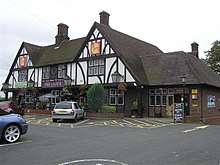
By the end of the 18th century a new room in the pub was established: the saloon. Beer establishments had always provided entertainment of some sort—singing, gaming or sport. Balls Pond Road in Islington was named after an establishment run by a Mr. Ball that had a duck pond at the rear, where drinkers could, for a fee, go out and take a potshot at the ducks.[53] More common, however, was a card room or a billiard room. The saloon was a room where, for an admission fee or a higher price of drinks, singing, dancing, drama, or comedy was performed and drinks would be served at the table. From this came the popular music hall form of entertainment—a show consisting of a variety of acts. A most famous London saloon was the Grecian Saloon in The Eagle, City Road, a pub which was referenced by name in the 18th century nursery rhyme: "Up and down the City Road / In and out The Eagle / That's the way the money goes / Pop goes the weasel."[54][51] This meant that the customer had spent all his money at The Eagle, and needed to pawn his "weasel" to get some more.[54] The meaning of the "weasel" is unclear but the two most likely definitions are: a flat iron used for finishing clothing; or rhyming slang for a coat (weasel and stoat).[55]
A few pubs have stage performances such as serious drama, stand-up comedy, musical bands, cabaret or striptease; however, juke boxes, karaoke and other forms of pre-recorded music have otherwise replaced the musical tradition of a piano or guitar and singing.
Public bar
The public bar, or tap room, was where the working class were expected to congregate and drink. It had unfurnished floorboards, sometimes covered with sawdust to absorb the spitting and spillages (known as "spit and sawdust"), bare bench seats and stools. Drinks were generally lower quality beers and liquors.[56] Public bars were seen as exclusive areas for only men; strictly enforced social etiquettes barred women from entering public bars (some pubs did not lift this rule until the 1980s).[57]
This style was in marked contrast to the adjacent saloon or lounge bar which, by the early 20th century, was where male or accompanied female middle-class drinkers would drink. It had carpeted floors, upholstered seats, and a wider selection of better quality drinks that cost a penny or two more than those served in the public bar.
By the mid 20th century, the standard of the public bar had generally improved. Pub patrons only had to choose between economy and exclusivity (or youth and age: a jukebox or dartboard). By the 1970s, divisions between saloons and public bars were being phased out, usually by the removal of the dividing wall or partition. While the names of saloon and public bar may still be seen on the doors of pubs, the prices (and often the standard of furnishings and decoration) are the same throughout the premises.[58] Most present day pubs now comprise one large room, although with the advent of gastropubs, some establishments have returned to maintaining distinct rooms or areas.
Snug
The "snug" was a small private room or area which typically had access to the bar and a frosted glass window, set above head height. A higher price was paid for beer in the snug and nobody could look in and see the drinkers. It was not only the wealthy visitors who would use these rooms. The snug was for patrons who preferred not to be seen in the public bar. Ladies would often enjoy a private drink in the snug in a time when it was frowned upon for women to be in a pub. The local police officer might nip in for a quiet pint, the parish priest for his evening whisky, or lovers for a rendezvous.
Campaign for Real Ale (CAMRA) have surveyed the 50,000 pubs in Britain and they believe that there are very few pubs that still have classic snugs. These are on a historic interiors list in order that they can be preserved.[59]
Counter
The pub took the concept of the bar counter to serve the beer from gin palaces in the 18th century.[60] Until that time beer establishments used to bring the beer out to the table or benches, as remains the practice in (for example) beer gardens and some other drinking establishments in Germany.[61] A bar might be provided for the manager or publican to do paperwork while keeping an eye on his or her customers, and the term "bar" applied to the publican's office where one was built,[62] but beer would be tapped directly from a cask or barrel sat on a table, or kept in a separate taproom and brought out in jugs.[63] When purpose built Victorian pubs were built after the Beerhouse Act 1830,[64] the main room was the public room with a large serving bar copied from the gin houses, the idea being to serve the maximum number of people in the shortest possible time. The other, more private, rooms had no serving bar—they had the beer brought to them from the public bar. There are a number of pubs in the Midlands or the North which still retain this set up, though these days the beer is fetched by the customer themself from the taproom or public bar. One of these is The Vine, known locally as The Bull and Bladder, in Brierley Hill near Birmingham, another the Cock at Broom, Bedfordshire a series of small rooms served drinks and food by waiting staff.[65] In the Manchester district the public bar was known as the "vault", other rooms being the lounge and snug as usual elsewhere. By the early 1970s there was a tendency to change to one large drinking room as breweries were eager to invest in interior design and theming.[66]
Isambard Kingdom Brunel, the British engineer and railway builder, introduced the idea of a circular bar into the Swindon station pub in order that customers were served quickly and did not delay his trains. These island bars became popular as they also allowed staff to serve customers in several different rooms surrounding the bar.[67][68]
Beer engine
A "beer engine" is a device for pumping beer, originally manually operated and typically used to dispense beer from a cask or container in a pub's basement or cellar.
The first beer pump known in England is believed to have been invented by John Lofting (b. Netherlands 1659-d. Great Marlow Buckinghamshire 1742) an inventor, manufacturer and merchant of London.
The London Gazette of 17 March 1691 published a patent in favour of John Lofting for a fire engine, but remarked upon and recommended another invention of his, for a beer pump:
"Whereas their Majesties have been Graciously Pleased to grant Letters patent to John Lofting of London Merchant for a New Invented Engine for Extinguishing Fires which said Engine have found every great encouragement. The said Patentee hath also projected a Very Useful Engine for starting of beer and other liquors which will deliver from 20 to 30 barrels an hour which are completely fixed with Brass Joints and Screws at Reasonable Rates. Any Person that hath occasion for the said Engines may apply themselves to the Patentee at his house near St Thomas Apostle London or to Mr. Nicholas Wall at the Workshoppe near Saddlers Wells at Islington or to Mr. William Tillcar, Turner, his agent at his house in Woodtree next door to the Sun Tavern London."
"Their Majesties" referred to were William and Mary, who had recently arrived from the Netherlands and had been appointed joint monarchs.
A further engine was invented in the late eighteenth century by the locksmith and hydraulic engineer Joseph Bramah (1748–1814).
Strictly the term refers to the pump itself, which is normally manually operated, though electrically powered and gas powered pumps are occasionally used.[69] When manually powered, the term "handpump" is often used to refer to both the pump and the associated handle.
Companies
After the development of the large London Porter breweries in the 18th century, the trend grew for pubs to become tied houses which could only sell beer from one brewery (a pub not tied in this way was called a Free house). The usual arrangement for a tied house was that the pub was owned by the brewery but rented out to a private individual (landlord) who ran it as a separate business (even though contracted to buy the beer from the brewery). Another very common arrangement was (and is) for the landlord to own the premises (whether freehold or leasehold) independently of the brewer, but then to take a mortgage loan from a brewery, either to finance the purchase of the pub initially, or to refurbish it, and be required as a term of the loan to observe the solus tie.
A trend in the late 20th century was for breweries to run their pubs directly, using managers rather than tenants. Most such breweries, such as the regional brewery Shepherd Neame in Kent and Young's and Fuller's in London, control hundreds of pubs in a particular region of the UK, while a few, such as Greene King, are spread nationally. The landlord of a tied pub may be an employee of the brewery—in which case he/she would be a manager of a managed house—or a self-employed tenant who has entered into a lease agreement with a brewery, a condition of which is the legal obligation (trade tie) only to purchase that brewery's beer. The beer selection is mainly limited to beers brewed by that particular company. The Beer Orders,[70] passed in 1989, were aimed at getting tied houses to offer at least one alternative beer, known as a guest beer, from another brewery. This law has now been repealed but while in force it dramatically altered the industry. Some pubs still offer a regularly changing selection of guest beers.
Organisations such as Wetherspoons, Punch Taverns and O'Neill's were formed in the UK in the wake of the Beer Orders. A PubCo is a company involved in the retailing but not the manufacture of beverages, while a Pub chain may be run either by a PubCo or by a brewery.
Pubs within a chain will usually have items in common, such as fittings, promotions, ambience and range of food and drink on offer. A pub chain will position itself in the marketplace for a target audience. One company may run several pub chains aimed at different segments of the market. Pubs for use in a chain are bought and sold in large units, often from regional breweries which are then closed down. Newly acquired pubs are often renamed by the new owners, and many people resent the loss of traditional names, especially if their favourite regional beer disappears at the same time.
In 2009 about half of Britain's pubs were owned by large pub companies.[71]
Brewery tap
A brewery tap is the nearest outlet for a brewery's beers. It is usually a room or bar in the brewery itself, although the name may be applied to the nearest pub. The term is not applied to a brewpub which brews and sells its beer on the same premises.
Types
A pub has no strict definition, but CAMRA states that a pub has four characteristics:[2]
- Open to the public without membership / residency
- Serve draught beer or cider without requiring food be consumed
- Have at least one indoor area not laid out for meals
- Allow drinks to be bought at a bar (i.e. not only table service)
Together these characteristics differentiate pubs from restaurants and hotel bars, although some pubs also serve as restaurants or hotels.
Gastropub
A gastropub is a hybrid pub and restaurant, notable for serving good quality beer, wine and food.[72] The name is a portmanteau of gastronomy and public house, and was coined in 1991 when David Eyre and Mike Belben took over The Eagle pub in Clerkenwell, London.[73] The concept of a restaurant in a pub reinvigorated both pub culture and British dining,[74] though has occasionally attracted criticism for potentially removing the character of traditional pubs.[75]
In 2011, The Good Food Guide suggested that the term has become irrelevant such is its commonality these days.[76]
Country pub

A "country pub" is simply a rural drinking establishment, though the term has acquired a romantic image typically of thatched roofs and whitewashed stone walls.[77] As with urban pubs, the country pub can function as a social and recreational centre, providing opportunities for folk to meet, exchange news, and cooperate on local charitable events.[78] However, that culture of functioning as a social centre for a village and rural community started to diminish in the later part of the 20th century as many country pubs either closed down, or were converted to restaurants or gastropubs.[79] Those country pubs located on main routes may once have been coaching inns, providing accommodation or refreshment for travellers before the advent of motorised transport.[80]
Roadhouse
The term roadhouse was originally applied to a coaching inn, but with the advent of popular travel by motor car in the 1920s and 1930s in the United Kingdom, a new type of roadhouse emerged, often located on the newly constructed arterial roads and bypasses. They were large establishments offering meals and refreshment and accommodation to motorists and parties travelling by charabanc. The largest roadhouses boasted facilities such as tennis courts and swimming pools. Their popularity ended with the outbreak of the Second World War when recreational road travel became impossible, and the advent of post-war drink driving legislation prevented their full recovery.[81] Many of these establishments are now operated as pub restaurants or fast food outlets.
Theme pub
A theme pub is a pub which aligns itself to a specific culture, style or activity; often with the intention of attracting a niche clientele. Many are decorated and furnished accordingly, with the theme sometimes dictating the style of food or drink on offer too. Examples of theme pubs include sports bars, rock pubs, biker pubs, Goth pubs, strip pubs, karaoke bars and Irish pubs.
Micropubs
A micropub is a very small, modern, one room pub founded on principles set up by Martyn Hillier, the creator of the first micropub, The Butchers Arms in Herne, Kent in 2005.[82][83] Micropubs are "based upon good ale and lively banter",[84] with, commonly, a strong focus on local cask ale.[85] It became easier to start a small pub after the passing of the 2003 Licensing Act, which became effective in 2005.[83]
Signs
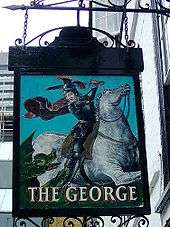
In 1393, King Richard II of England compelled landlords to erect signs outside their premises. The legislation stated "Whosoever shall brew ale in the town with intention of selling it must hang out a sign, otherwise he shall forfeit his ale."[86] This law was to make alehouses easily visible to passing inspectors, borough ale tasters, who would decide the quality of the ale they provided. William Shakespeare's father, John Shakespeare, was one such inspector.
Another important factor was that during the Middle Ages a large proportion of the population would have been illiterate and so pictures on a sign were more useful than words as a means of identifying a public house. For this reason there was often no reason to write the establishment's name on the sign and inns opened without a formal written name, the name being derived later from the illustration on the pub's sign.
The earliest signs were often not painted but consisted, for example, of paraphernalia connected with the brewing process such as bunches of hops or brewing implements, which were suspended above the door of the pub. In some cases local nicknames, farming terms and puns were used. Local events were often commemorated in pub signs. Simple natural or religious symbols such as 'The Sun', 'The Star' and 'The Cross' were incorporated into pub signs, sometimes being adapted to incorporate elements of the heraldry (e.g. the coat of arms) of the local lords who owned the lands upon which the pub stood. Some pubs have Latin inscriptions.
Other subjects that lent themselves to visual depiction included the name of battles (e.g. Trafalgar), explorers, local notables, discoveries, sporting heroes and members of the royal family. Some pub signs are in the form of a pictorial pun or rebus. For example, a pub in Crowborough, East Sussex called The Crow and Gate had for some years an image of a crow with gates as wings. A British Pathe News film of 1956 shows artist Michael Farrar-Bell at work producing inn signs.[87]
Most British pubs still have decorated signs hanging over their doors, and these retain their original function of enabling the identification of the pub. Today's pub signs almost always bear the name of the pub, both in words and in pictorial representation. The more remote country pubs often have stand-alone signs directing potential customers to their door.
Names
Pub names are used to identify and differentiate each pub. Modern names are sometimes a marketing ploy or attempt to create "brand awareness", frequently using a comic theme thought to be memorable, Slug and Lettuce for a pub chain being an example. Interesting origins are not confined to old or traditional names, however. Names and their origins can be broken up into a relatively small number of categories.[88]
As many pubs are centuries old, many of their early customers were unable to read, and pictorial signs could be readily recognised when lettering and words could not be read.[89]
Pubs often have traditional names. A common name is the "Marquis of Granby". These pubs were named after John Manners, Marquess of Granby, who was the son of John Manners, 3rd Duke of Rutland and a general in the 18th-century British Army. He showed a great concern for the welfare of his men, and on their retirement, provided funds for many of them to establish taverns, which were subsequently named after him.[90] All pubs granted their license in 1780 were called the Royal George,[91] after King George III, and the twentieth anniversary of his coronation.
Some names for pubs that seem absurd or whimsical have come from corruptions of old slogans or phrases, such as "The Bag o'Nails" (Bacchanals), "The Goat and Compasses" (God Encompasseth Us),[92] "The Cat and the Fiddle" (Chaton Fidèle: Faithful Kitten) and "The Bull and Bush", which purportedly celebrates the victory of Henry VIII at "Boulogne Bouche" or Boulogne-sur-Mer Harbour.[93][94]
Entertainment
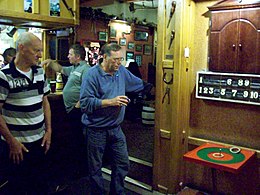
Traditional games are played in pubs, ranging from the well-known darts,[95] skittles,[96] dominoes,[97] cards and bar billiards,[98] to the more obscure Aunt Sally,[99] nine men's morris[100] and ringing the bull.[101] In the UK betting is legally limited to certain games such as cribbage or dominoes, played for small stakes. In recent decades the game of pool[102] (both the British and American versions) has increased in popularity as well as other table based games such as snooker[103] or table football becoming common.
Increasingly, more modern games such as video games and slot machines are provided. Pubs hold special events, from tournaments of the aforementioned games to karaoke nights to pub quizzes. Some play pop music and hip-hop (dance bar), or show football and rugby union on big screen televisions (sports bar). Shove ha'penny[104] and Bat and trap[105] were also popular in pubs south of London.
Some pubs in the UK also have football teams composed of regular customers. Many of these teams are in leagues that play matches on Sundays, hence the term "Sunday League Football". Bowling is found in association with pubs in some parts of the country and the local team will play matches against teams invited from elsewhere on the pub's bowling green.
Pubs may be venues for pub songs and live music. During the 1970s pubs provided an outlet for a number of bands, such as Kilburn and the High Roads, Dr. Feelgood and The Kursaal Flyers, who formed a musical genre called Pub rock that was a precursor to Punk music.
Food
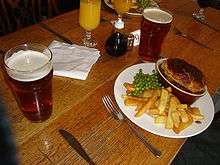
Some pubs have a long tradition of serving food, dating back to their historic usage as inns and hotels where travellers would stay.
Many pubs were drinking establishments, and little emphasis was placed on the serving of food, other than sandwiches and "bar snacks", such as pork scratchings, pickled eggs, salted crisps and peanuts which helped to increase beer sales.[106] In South East England (especially London) it was common until recent times for vendors selling cockles, whelks, mussels, and other shellfish to sell to customers during the evening and at closing time. Many mobile shellfish stalls would set up near pubs, a practice that continues in London's East End. Otherwise, pickled cockles and mussels may be offered by the pub in jars or packets.
In the 1950s some British pubs would offer "a pie and a pint", with hot individual steak and ale pies made easily on the premises by the proprietor's wife during the lunchtime opening hours.[106] The ploughman's lunch became popular in the late 1960s,[106] as did the convenient "chicken in a basket", a portion of roast chicken with chips, served on a napkin in a wicker basket.[106]
Family chain pubs which served food in the evenings gained popularity in the 1970s, and included Berni Inn and Beefeater.[106]
Quality dropped but variety increased with the introduction of microwave ovens and freezer food. "Pub grub" expanded to include British food items such as steak and ale pie, shepherd's pie, fish and chips, bangers and mash, Sunday roast, ploughman's lunch, and pasties. In addition, dishes such as burgers, chicken wings, lasagne and chilli con carne are often served.[107][108] Some pubs offer elaborate hot and cold snacks free to customers at Sunday lunchtimes, to prevent them getting hungry and leaving for their lunch at home.
Since the 1990s food has become a more important part of a pub's trade, and today most pubs serve lunches and dinners at the table in addition to (or instead of) snacks consumed at the bar. They may have a separate dining room. Some pubs serve meals to a higher standard, to match good restaurant standards; these are sometimes termed gastropubs.
Listed
CAMRA maintains a "National Inventory" of historical notability and of architecturally and decoratively notable pubs.[109] The National Trust owns thirty-six public houses of historic interest including the George Inn, Southwark, London and The Crown Liquor Saloon, Belfast, Northern Ireland.[110][111]
Records
.jpg)

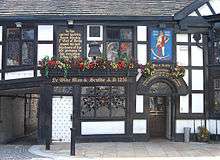
Highest and remotest
The highest pub in the United Kingdom is the Tan Hill Inn, Yorkshire, at 1,732 feet (528 m) above sea level. The remotest pub on the British mainland is The Old Forge in the village of Inverie, Lochaber, Scotland. There is no road access and it may only be reached by an 18-mile (29 km) walk over mountains, or a 7-mile (11 km) sea crossing.[112]
Smallest
Contenders for the smallest public house in the UK include:[111]
- The Nutshell – Bury St Edmunds, Suffolk
- The Lakeside Inn – Southport, Merseyside
- The Little Gem – Aylesford, Kent
- The Smiths Arms – Godmanstone, Dorset
- The Signal Box Inn[113] – Cleethorpes, Lincolnshire
The list includes a small number of parlour pubs, one of which is the Sun Inn in Leintwardine, Herefordshire.
The smallest public house in Wales is claimed by Y Goron Fach (The Little Crown) in Denbigh, with a single bar of 15 square metres (160 sq ft).
Largest
The largest pub in the UK is the Royal Victoria Pavilion, in Ramsgate, Kent. The venue was previously a casino and before that a theatre.[114]
Oldest
A number of pubs claim to be the oldest surviving establishment in the United Kingdom, although in several cases original buildings have been demolished and replaced on the same site. Others are ancient buildings that were used for purposes other than as a pub previously in their history. Ye Olde Fighting Cocks in St Albans, Hertfordshire, holds the Guinness World Record for the oldest pub in England, as it is an 11th-century structure on an 8th-century site. Ye Olde Trip to Jerusalem in Nottingham is claimed to be the "oldest inn in England". It has a claimed date of 1189, based on the fact it is constructed on the site of the Nottingham Castle brewhouse; the present building dates from around 1650.[115] Likewise, The Nags Head in Burntwood, Staffordshire only dates back to the 16th century, while it has been claimed that a pub on the site is mentioned in the Domesday book, Burntwood is not in fact listed.[116]
There is archaeological evidence that parts of the foundations of The Old Ferryboat Inn in Holywell may date to AD 460, and there is evidence of ale being served as early as AD 560.[117]
The Bingley Arms, Bardsey, Yorkshire, is claimed to date to 905 AD. Ye Olde Salutation Inn in Nottingham dates from 1240, although the building served as a tannery and a private residence before becoming an inn sometime before the English Civil War. The Adam and Eve in Norwich was first recorded in 1249, when it was an alehouse for the workers constructing nearby Norwich Cathedral.[118] Ye Olde Man & Scythe in Bolton, Greater Manchester, is mentioned by name in a charter of 1251, but the current building is dated 1631. Its cellars are the only surviving part of the older structure.
Longest and shortest name
The town of Stalybridge in Greater Manchester is thought to have the pubs with both the longest and shortest names in the United Kingdom – The Old Thirteenth Cheshire Astley Volunteer Rifleman Corps Inn and the Q Inn, both operating as of 2019 (the Rifleman reopening in new premises, moving from Astley Street to premises two doors away from the Q Inn in Market Street in 2019, after being closed for three years).[119][120] The original Rifleman building retains a pub sign, and a blue plaque from 1995 recording the recognition of the name in the Guinness Book of Records.[121]
Statistics
- The most expensive place to get a pint of beer is in Doha, Qatar, where prices average £10.30 (2019).[122]
- The average retail price of a pint of beer in the UK is £4.12 (2019).[122]
- The cheapest place to get a beer in the UK is Preston, where a pint costs on average £3.06 (2019).[122]
- In 2018, Brits drank 7.75 billion pints of beer: 21.2 million pints a day.[123]
- As of 2019, there are 40,683 pubs in England, 2,901 in Wales and 3,612 in Scotland.[124]
- Pubs are closing at a rate of one every 12 hours (as of February 2019).[124]
Decline
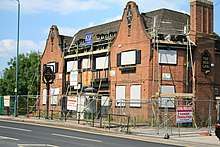
The number of pubs in the UK has declined year on year, at least since 1982.[125] Various reasons are put forward for this, such as the failure of some establishments to keep up with customer requirements.[126] Others claim the smoking ban of 2007, intense competition from gastro-pubs, the availability of cheap alcohol in supermarkets or the general economic climate are either to blame, or are factors in the decline.[127] Changes in demographics may be an additional factor.[128]
In 2015 the rate of pub closures came under the scrutiny of Parliament in the UK, with a promise of legislation to improve relations between owners and tenants.[129] The Lost Pubs Project listed 31,301 closed English pubs on 19 July 2016, with photographs of over 16,000.[130]
In the fifteen years to 2017 a quarter of London's pubs had closed. The closures have been ascribed to factors such as changing tastes, rise in the cost of beer due to applied taxes and the increase in the Muslim population.[131]
Cultural associations
Inns and taverns feature throughout English literature and poetry, from The Tabard Inn in Chaucer's Canterbury Tales onwards.[132]
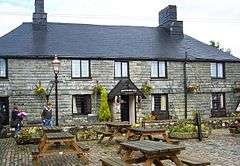
The highwayman Dick Turpin used the Swan Inn at Woughton-on-the-Green in Buckinghamshire as his base.[133] Jamaica Inn near Bolventor in Cornwall gave its name to a 1936 novel by Daphne du Maurier and a 1939 film directed by Alfred Hitchcock.[134] In the 1920s John Fothergill (1876–1957) was the innkeeper of the Spread Eagle in Thame, Berkshire, and published his autobiography: An Innkeeper's Diary (London: Chatto & Windus, 1931).[135] During his idiosyncratic occupancy many famous people came to stay, such as H. G. Wells. United States president George W. Bush fulfilled his lifetime ambition of visiting a 'genuine British pub' during his November 2003 state visit to the UK when he had lunch and a pint of non-alcoholic lager (Bush being a teetotaler) with British Prime Minister Tony Blair at the Dun Cow pub in Sedgefield, County Durham in Blair's home constituency.[136] There were approximately 53,500 public houses in 2009 in the United Kingdom.[137] This number has been declining every year, so that nearly half of the smaller villages no longer have a local pub.[138]
London
Many of London's pubs are known to have been used by famous people, but in some cases, such as the association between Samuel Johnson and Ye Olde Cheshire Cheese, this is speculative, based on little more than the fact that the person is known to have lived nearby. However, Charles Dickens is known to have visited the Cheshire Cheese, the Prospect of Whitby, Ye Olde Cock Tavern and many others. Samuel Pepys is also associated with the Prospect of Whitby and the Cock Tavern.
The Fitzroy Tavern[139] is a pub situated at 16 Charlotte Street in the Fitzrovia district, to which it gives its name. It became famous (or according to others, infamous) during a period spanning the 1920s to the mid-1950s as a meeting place for many of London's artists, intellectuals and bohemians such as Dylan Thomas, Augustus John, and George Orwell. Several establishments in Soho, London, have associations with well-known, post-war literary and artistic figures, including the Pillars of Hercules, The Colony Room and the Coach and Horses. The Canonbury Tavern, Canonbury, was the prototype for Orwell's ideal English pub, The Moon Under Water.
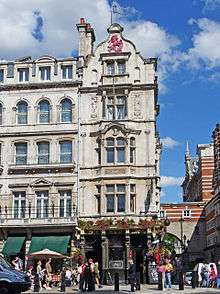
The Red Lion in Whitehall is close to the Palace of Westminster and is consequently used by political journalists and Members of Parliament. The pub is equipped with a Division bell that summons MPs back to the chamber when they are required to take part in a vote.[140] The Punch Bowl, Mayfair was at one time jointly owned by Madonna and Guy Ritchie.[141] The Coleherne public house in Earls Court was a well-known gay pub from the 1950s. It attracted many well-known patrons, such as Freddie Mercury, Kenny Everett and Rudolph Nureyev. It was used by the serial-killer Colin Ireland to pick up victims.
Jack Straw's Castle was a pub named after Jack Straw, one of the three leaders of Peasants' Revolt, the pub was active since 14th century until its destruction by The Blitz during second world war.
In 1966 The Blind Beggar in Whitechapel became infamous as the scene of a murder committed by gangster Ronnie Kray.[142] The Ten Bells is associated with several of the victims of Jack the Ripper. In 1955, Ruth Ellis, the last woman executed in the United Kingdom, shot David Blakely as he emerged from The Magdala in South Hill Park, Hampstead,[143] the bullet holes can still be seen in the walls outside. It is said that Vladimir Lenin and a young Joseph Stalin met in the Crown and Anchor pub (now known as The Crown Tavern) on Clerkenwell Green when the latter was visiting London in 1903.[144]
The Angel, Islington was formerly a coaching inn, the first on the Great North Road, the main route northwards out of London, where Thomas Paine is believed to have written much of The Rights of Man. It was mentioned by Charles Dickens, became a Lyons Corner House, and is now a Co-operative Bank.
Oxford and Cambridge
The Eagle and Child and the Lamb and Flag, Oxford, were regular meeting places of the Inklings, a writers' group which included J. R. R. Tolkien and C. S. Lewis. The Eagle in Cambridge is where Francis Crick interrupted patrons' lunchtime on 28 February 1953 to announce that he and James Watson had "discovered the secret of life" after they had come up with their proposal for the structure of DNA.[145] The anecdote is related in Watson's book The Double Helix.[146] and commemorated with a blue plaque on the outside wall.
Outside Great Britain
.jpg)
Although "British" pubs found outside of Britain and its former colonies are often themed bars owing little to the original British pub, a number of "true" pubs may be found around the world.
In Scandinavia, especially Denmark, a number of pubs have opened which eschew "theming", and which instead focus on the business of providing carefully conditioned beer, often independent of any particular brewery or chain, in an environment which would not be unfamiliar to a British pub-goer. Some import British cask ale, rather than beer in kegs, to provide the full British real ale experience to their customers. This newly established Danish interest in British cask beer and the British pub tradition is reflected by the fact that some 56 British cask beers were available at the 2008 European Beer Festival in Copenhagen, which was attended by more than 20,000 people.
In Ireland, pubs are known for their atmosphere or "craic".[147] In Irish, a pub is referred to as teach tábhairne ("tavernhouse") or teach óil ("drinkinghouse"). Live music, either sessions of traditional Irish music or varieties of modern popular music, is frequently featured in the pubs of Ireland. Pubs in Northern Ireland are largely identical to their counterparts in the Republic of Ireland except for the lack of spirit grocers. A side effect of "The Troubles" was that the lack of a tourist industry meant that a higher proportion of traditional bars have survived the wholesale refitting of Irish pub interiors in the 'English style' in the 1950s and 1960s. New Zealand sports a number of Irish pubs.[148]
Pubs have a long history in Canada, with some still operating after 200 years, like the Olde Angel Inn in Niagara-on-the-Lake. A fake "English looking" pub trend started in the 1990s, built into existing storefronts, often run by corporate pub firms. Most universities in Canada have campus pubs which are central to student life, serving food and drink as well as hosting social events. Often these pubs are run by the student's union and at some universities, a budget is reserved for course pub nights. The gastropub concept has caught on, as traditional British influences are to be found in many Canadian dishes. Aside from pubs, the term bar can refer to themed drinking establishments, sports bars, or cocktail bars, or to the physical counter in a pub. Tavern was previously a popular term, though it has become somewhat antiquated.
In fiction
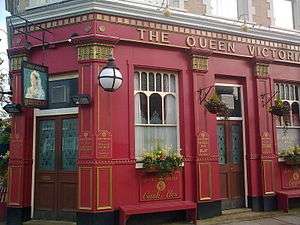
Pubs are a common setting for fictional works, including novels, stories, films, video games, and other works. In many cases, authors and other creators develop imaginary pubs for their works, some of which have become notable fictional places. Notable fictional pubs include The Admiral Benbow Inn in the Treasure Island pirate story, The Garrison in the 1920s crime TV drama Peaky Blinders, The Golden Perch in the high fantasy novel Lord of the Rings, The Hog's Head pub in the Harry Potter fantasy series, Moe's Tavern, a working-class venue in The Simpsons, and The Oak and Crosier in The Elder Scrolls IV: Oblivion video game.
The major soap operas on British television each feature a fictional pub, and these pubs have become household names in Britain.[149] The Rovers Return is the pub in Coronation Street, the British soap broadcast on ITV. The Queen Vic (short for the Queen Victoria) is the pub in EastEnders, the major soap on BBC One and the Woolpack in ITV's Emmerdale. The sets of each of the three major television soap operas have been visited by some of the members of the royal family, including Queen Elizabeth II. The centrepiece of each visit was a trip into the Rovers,[150] the Queen Vic,[151] or the Woolpack to be offered a drink. The Bull in the BBC Radio 4 soap opera The Archers is an important meeting point.
See also
- Tavern
- Bar
- Campaign for Real Ale
- Pub crawl
- Public houses in Ireland
- Public houses in Australia
- List of award-winning pubs in London
- List of microbreweries
- List of public house topics
- List of public houses in Australia
References
- "Origins of the English pub" (PDF). Stephen Cooper.
- GLA Economics, Closing time: London's public houses, 2017
- "History of the pub". Beer and Pub Association. Archived from the original on 3 July 2008.
- "Great British Pub". Archived from the original on 14 February 2012.
- "Public House". Encyclopædia Britannica.
- Cronin, Michael; O'Connor, Barbara (2003). Barbara O'Connor (ed.). Irish Tourism: image, culture, and identity. Tourism and Cultural Change. 1. Channel View Publications. p. 83. ISBN 978-1-873150-53-5. Retrieved 27 March 2011.
- Australian Drinking Culture Convict Creations. Retrieved 24 April 2011.
- "In praise of ... pubs". The Guardian. 10 December 2016. Archived from the original on 21 December 2016.
- Pete Brown (18 August 2016). The Pub: A Cultural Institution. Jacqui Small LLP. p. 29.
- Frank Stenton (1970). Anglo Saxon England. ISBN 9780198217169.
- "Company History". Innholders Company.
- Monckton, Herbert Anthony (1966), A History of English Ale and Beer, Bodley Head (p. 101)
- Hanson, David J (May 2013). Historical evolution of alcohol consumption in society. Oxford University Press Scholarship Online. doi:10.1093/acprof:oso/9780199655786.001.0001. ISBN 9780199655786.
- "8 Ways Roads Helped Rome Rule the Ancient World". HISTORY.com. 29 August 2018. Archived from the original on 24 December 2019. Retrieved 3 February 2020.
- Pub Rooms, pub accommodation Archived 28 January 2016 at the Wayback Machine.
- Phillips, Roderick (2014). Alcohol A History. The University of North Carolina Press.
- "Gin Renaissance in City of London". Farmers & Fletcher. Archived from the original on 12 September 2018. Retrieved 27 April 2020.
- "William Hogarth, Gin Lane, etching and engraving". British Museum – via Google Arts & Culture.
- "Beer Houses". AMLWCH History. Archived from the original on 17 December 2007.
- "Beer Houses". History UK. Archived from the original on 19 May 2009.
- "Beer houses". Old Cannon Brewery. Archived from the original on 10 January 2007.
- "How did historic alehouses taverns and inns evolve into the pubs we see today?". Morning Advertiser.
- "The Oxford Companion to Beer definition of public houses (pubs)". Craft Beer and Brewing.
- Haydon, Peter (1994). The English Pub, A History. London: Robert Hale Limited. pp. 197–220. ISBN 9-780709-056942.
- "Greene King". Staff handbook.
- "The Tied House System". Craft Beer and Brewing.
- "House of Commons Select Committee on Trade and Industry report". Parliament of the United Kingdom.
- Spicer, Thurman, Walters, Ward, John, Chris, John, Simon (2011). Intervention in the Modern UK Brewing Industry. London: Palgrave Macmillan. pp. 152–164. ISBN 9780230298576.CS1 maint: multiple names: authors list (link)
- The National Cyclopaedia of Useful Knowledge, Vol 1, London, Charles Knight, 1847, pp. 410–1.
- "'The vices and virtue of drink (17th–18th centuries)'- news :: You Are What You Ate". University of Leeds. Archived from the original on 16 March 2017. Retrieved 16 March 2017.
- Beat, Kümin (1 April 2005). "Drinking and Public Space in Early Modern German Lands". Contemporary Drug Problems. 32 (1). ISSN 0091-4509. Archived from the original on 16 March 2017.
- "Tavern regulation debate – Module Forum: The World of the Tavern (HI390)". University of Warwick. Archived from the original on 16 March 2017. Retrieved 16 March 2017.
- Archives, The National. "The National Archives – Homepage". The National Archives. Retrieved 18 November 2019.
- Fahey, David M. (1979). "The Politics of Drink: Pressure Groups and the British Liberal Party, 1883–1908". Social Science. 54 (2): 76–85. JSTOR 41886377.
- Donald Read, Edwardian England, 1901–15: society and politics (1972) p 52.
- Colin Cross, The Liberals in Power, 1905–1914 (1963) pp. 69–71.
- Paul Jennings, "Liquor Licensing and the Local Historian: The Victorian Public House." Local Historian 41 (2011): 121–137.
- "Defence of the Realm Act". Spartacus.schoolnet.co.uk. Archived from the original on 3 April 2009. Retrieved 26 June 2009.
- "Awards by the Pembrokeshire Authority". Western Mail. British Newspaper Archive. 28 September 1914. Retrieved 10 August 2015.
- "Licensing – A Brief History". Archived from the original on 23 September 2015. Retrieved 10 August 2015.
- Seabury, Olive (2007). The Carlise State Management Scheme: Its Ethos and Architecture. A 60-year experiment in regulation of the liquor trade. ISBN 978-1-904147-30-5. Archived from the original on 2 January 2008.
- "Licensing Act 2003 (c. 17)". Government of the United Kingdom. 10 July 2003. Archived from the original on 17 May 2008. Retrieved 26 June 2009.
- "Hospital alcohol admissions soar". BBC NEWS. London. 22 May 2008. Archived from the original on 26 May 2008. Retrieved 22 May 2008.
- "R.I.P. Lock-ins". BBC News. London. 23 November 2005. Archived from the original on 4 June 2009. Retrieved 21 July 2009.
- Mike Keegan (9 June 2008). "'Smoking lock-ins' flaunt ban | Manchester Evening News". menmedia.co.uk. Retrieved 4 November 2012.
- Langton, David (1 December 2006). "Ban on smoking in pubs to come into force on 1 July – UK Politics, UK". The Independent. London. Archived from the original on 28 May 2009. Retrieved 10 July 2008.
- Lusher, Adam; Goslett, Miles (3 June 2007). "Hundreds of pubs to flout smoking ban – Telegraph". The Daily Telegraph. London. Archived from the original on 13 July 2009. Retrieved 21 July 2009.
- "The Publican – Home – Smoking out the truth on the ban – two years on". thepublican.com. Archived from the original on 17 July 2011. Retrieved 21 July 2009.
- "UPDATE 3-Wetherspoon sees FY profit at top end of forecasts". Reuters. 15 July 2009. Archived from the original on 18 July 2009. Retrieved 21 July 2009.
- Werdigier, Julia (26 January 2008). "Scottish & Newcastle Agrees to Be Bought and Split". The New York Times. Archived from the original on 4 September 2015. Retrieved 22 May 2010.
- "Pop Goes the Weasel". Nursery Rhymes Lyrics and Origins. Retrieved 23 July 2019.
- Kerley, Paul (28 August 2015). "Are these England's most beautiful pubs?". BBC News Magazine. Archived from the original on 29 August 2015.
- SilkTork. "Time Gentlemen Please!". Archived from the original on 28 January 2013. Retrieved 12 May 2013.
- David Kemp (1992) The pleasures and treasures of Britain: a discerning traveller's companion p.158. Dundurn Press Ltd., 1992
- "Time Gentlemen Please!". Ratebeer.com. Archived from the original on 20 February 2009. Retrieved 26 June 2009.
- "Oxford dictionaries: spit and sawdust". Archived from the original on 22 July 2015. Retrieved 30 April 2015.
- "30 years ago: El Vino's treatment of women drinkers ruled unlawful". The Guardian. 15 November 2012.
- Fox, Kate (1996) Passport to the Pub: tourist's guide to pub etiquette "Archived copy". Archived from the original on 10 May 2010. Retrieved 25 February 2010.CS1 maint: archived copy as title (link)
- Derbyshire – Spondon, Malt Shovel Archived 21 August 2014 at the Wayback Machine, Heritagepubs, CAMRA. Retrieved 27 August 2014.
- Phil Mellows (5 March 2019). "How-did-historic-alehouses-taverns-and-inns-evolve-into-the-pubs-we-see-today". morningadvertiser.co.uk.
- Geoffrey K. Brandwood; Andrew Davison; Michael Slaughter (2004). Licensed to sell: the history and heritage of the public house. English Heritage. p. 93. ISBN 1-85074-906-X. Retrieved 15 October 2010.
- Paul Jennings (5 February 2016). A History of Drink and the English, 1500–2000. Routledge. p. 80.
- Geoff Brandwood. "The vanishing faces of the traditional pub" (PDF). breweryhistory.com.
- Nick Collins (28 January 2011). "The rise and fall of the British pub". The Daily Telegraph.
- "The Cock at Broom – 01767 314411 One of England's Real Heritage Pubs". thecockatbroom.co.uk. Archived from the original on 16 May 2015.
- Evans, David G., et al. (1975) The Manchester Pub Guide, Manchester and Salford City Centres. Manchester: Manchester Pub Surveys; pp. 1–4
- "Time Gentlemen Please!". ratebeer.com. Archived from the original on 6 February 2010. Retrieved 15 October 2010.
- Stuart Cole (2007). West from Paddington. Etica Press Ltd. p. 30. ISBN 978-1-905633-05-0. Retrieved 15 October 2010.
- "In the Pub". CAMRA. Archived from the original on 20 April 2011. Retrieved 26 June 2009.
- "The Supply of Beer nationalarchives.gov.uk". Archived from the original on 10 April 2004. Retrieved 9 March 2015.
- "Pubs 'face mass closure threat'". BBC. 27 January 2009. Retrieved 1 May 2015.
- Farley, David (24 May 2009). "New York Develops a Taste for Gastropubs". The Washington Post.
- Norrington-Davies, Tom (24 November 2005). "Is the gastropub making a meal of it?". The Daily Telegraph. London. Retrieved 10 July 2008.
- "American gastropub: what's in a name?". Art Culinaire. via findarticles.com. Spring 2007. Archived from the original on 3 March 2008. Retrieved 23 July 2008.
- Norrington-Davies, Tom (24 November 2005). "Is the gastropub making a meal of it? – Telegraph". The Daily Telegraph. London. Archived from the original on 1 June 2009. Retrieved 21 July 2009.
- "Gastropub RIP". The Good Food Guide. 4 September 2011. Archived from the original on 17 May 2013. Retrieved 22 July 2013.
- Pete Brown (18 August 2016). The Pub: A Cultural Institution. Jacqui Small LLP. p. 130.
- House of Commons: Business, Innovation and Skills Committee (25 March 2010). Pub companies: follow-up, Government response to the Committee's fifth report of session 2009–10. The Stationery Office. p. 7.
- The more recent developments of the country pub Archived 20 November 2008 at the Wayback Machine
- "The Country Pub". Southern Life (UK). Archived from the original on 12 October 2008.CS1 maint: unfit url (link)
- Gutzke, David W (2005). "Improved Pubs and Road Houses: Rivals for Public Affection in Interwar England". breweryhistory.com. The Brewery History Society. Retrieved 3 April 2016.
- Jamie Hailstone (11 June 2015). "Small is beautiful – the quiet rise of the micropub". Morning Advertiser.
- Hawkes, Will (17 February 2011). "A local pub for local people: 'Micropubs' are catching on". The Independent. Archived from the original on 2 October 2016. Retrieved 9 November 2012.
- "Micropub Assoc – The Butcher's Arms". micropub.co.uk.
- "Community fixers? The mighty rise of the micropub". New Statesman. Archived from the original on 3 July 2015.
- "QI: some quite interesting facts about pubs". The Telegraph. 10 December 2016. Archived from the original on 12 April 2018.
- Video of artist Michael Farrar-Bell producing inn signs from British Pathe News
- "The History Press | A history of British pub names". www.thehistorypress.co.uk. Retrieved 27 August 2019.
- "Culture UK – Pub and Inn Signs". Historic-uk.com. Archived from the original on 8 February 2012. Retrieved 4 November 2012.
- "The Inn Crowd". The Telegraph. 30 September 2016. ISSN 0307-1235. Retrieved 27 August 2019.
- "Royal George, Cottingham". whatpub.com. Retrieved 27 August 2019.
- Brewer, E. Cobham (1989) Brewer's Dictionary of Phrase and Fable; 14th ed., by Ivor H. Evans. London: Cassell; p. 482 where it is thought unlikely, and two other suggestions are given
- Brewer, E. Cobham (1898). "Dictionary of Phrase and Fable". Archived from the original on 15 June 2008. Retrieved 17 October 2008.
- Dictionary of Pub Names – Google Books. 10 September 2006. ISBN 978-1-84022-266-1. Retrieved 31 August 2009.
- James Masters. "The History of Darts and other Useful Information". Tradgames.org.uk. Archived from the original on 14 June 2009. Retrieved 26 June 2009.
- James Masters. "Skittles, Nine Pins – Online guide". Tradgames.org.uk. Archived from the original on 2 June 2009. Retrieved 26 June 2009.
- James Masters. "Dominoes – Online Guide". Tradgames.org.uk. Archived from the original on 14 June 2009. Retrieved 26 June 2009.
- James Masters (21 February 1936). "Bar Billiards – Online Guide". Tradgames.org.uk. Archived from the original on 28 June 2009. Retrieved 26 June 2009.
- James Masters. "Aunt Sally – The Online Guide". Tradgames.org.uk. Archived from the original on 15 June 2009. Retrieved 26 June 2009.
- James Masters. "Nine Mens Morris, Mill – Online guide". Tradgames.org.uk. Archived from the original on 18 June 2009. Retrieved 26 June 2009.
- James Masters. "Ringing the Bull – History and information". Tradgames.org.uk. Archived from the original on 18 June 2009. Retrieved 26 June 2009.
- James Masters. "History of Pool and Carom Billiards – Online Guide". Tradgames.org.uk. Archived from the original on 28 June 2009. Retrieved 26 June 2009.
- James Masters. "Billiards and Snooker – Online guide". Tradgames.org.uk. Archived from the original on 2 July 2009. Retrieved 26 June 2009.
- James Masters. "Shove Ha'penny – Online Guide". Tradgames.org.uk. Archived from the original on 15 June 2009. Retrieved 26 June 2009.
- James Masters. "Bat and Ball Games – Online Guide". Tradgames.org.uk. Archived from the original on 3 March 2009. Retrieved 26 June 2009.
- "Nostalgia: Latest Nostalgia pieces from Gazette Live". Rememberwhen.gazettelive.co.uk. Archived from the original on 28 March 2014. Retrieved 9 March 2015.
- Barry, Tina (29 April 2005). "Better Pub Grub". The Brooklyn Paper. Archived from the original on 12 May 2013. Retrieved 22 July 2013.
- "Pub grub gets out of pickle". The Mirror. 27 June 2005. Archived from the original on 25 May 2014. Retrieved 22 July 2013.
- "CAMRA National Inventory". 19 February 2012. Archived from the original on 19 February 2012. Retrieved 9 March 2015.
- Trinder-Widdess, Zoe. "National Trust Website". Nationaltrust.org.uk. Archived from the original on 23 May 2006. Retrieved 26 June 2009.
- Evans, Jeff (2004) The Book of Beer Knowledge: essential wisdom for the discerning drinker. St Albans: CAMRA Books ISBN 1-85249-198-1
- "The Old Forge". The Old Forge. Archived from the original on 14 August 2010. Retrieved 7 July 2010.
- John White of White Beer Travels. "Signal Box Inn". Whitebeertravels.co.uk. Archived from the original on 6 March 2012. Retrieved 4 November 2012.
- Historic England. "Royal Victoria Pavilion (1336672)". National Heritage List for England. Retrieved 7 December 2019.
- "The Legend of Ye Olde Trip To Jerusalem". Ye Olde Trip to Jerusalem. Archived from the original on 16 October 2009. Retrieved 24 June 2010.
- "Domeday book". Retrieved 18 April 2019.
- "Oldest Inn in Britain". fatbadgers.co.uk. Archived from the original on 19 August 2009. Retrieved 29 August 2009.
- Peter Sargent. "Adam and Eve pub Bishopgate, Norwich". Eastern Daily Press. Archived from the original on 19 October 2010.
- Maya Wolfe-Robinson (16 July 2019). "Pub with longest name in UK reopens next to pub with shortest". The Guardian.
- Sam Yarwood (15 July 2019). "Pub with longest name in the country reopens in Tameside – two doors down from the pub with the shortest – Manchester Evening News". Manchester Evening News.
- "Blue Plaque – The Rifleman Inn". Tameside Metropolitan Borough. Retrieved 16 July 2019.
- Johnson, Georgia-Rose (31 July 2019). "The average price of a pint in 150+ countries | interactive world map". Finder UK. Retrieved 14 October 2019.
- "25th July 2018". British Beer and Pub Association. Retrieved 14 October 2019.
- Johnson, Jamie (24 February 2019). "Pubs are closing down at a rate of one every 12 hours, new figures show". The Telegraph. ISSN 0307-1235. Retrieved 14 October 2019.
- British Beer and Pub Association – Statistics, "Archived copy". Archived from the original on 24 November 2014. Retrieved 24 November 2014.CS1 maint: archived copy as title (link)
- "4000 pubs stuck in the 1980s". Archived from the original on 16 October 2015. Retrieved 1 May 2015.
- "Last orders for struggling Welsh pubs". BBC. 28 August 2010. Archived from the original on 16 October 2015. Retrieved 1 May 2015.
- "Why are British pubs closing down? (video)". BBC. 6 March 2015. Archived from the original on 22 May 2015. Retrieved 1 May 2015.
- "Pub companies, pub tenants & pub closures: recent developments – Commons Library Standard Note". Archived from the original on 27 February 2015. Retrieved 1 May 2015.
- "The Lost Pubs Project". Archived from the original on 8 July 2016. Retrieved 19 July 2016.
- "Archived copy". Archived from the original on 25 August 2017. Retrieved 25 August 2017.CS1 maint: archived copy as title (link) Why London’s pubs are disappearing
- Shelley, Henry C. (Henry Charles). "Inns and Taverns of Old London". infomotions.com. Archived from the original on 17 February 2012. Retrieved 21 July 2009.
- Highwaymen, Historic UK, archived from the original on 5 February 2012, retrieved 13 May 2012
- Paschke, Jean (March 2007). "The Cornwall of Daphne du Maurier". britishheritage.com. British Heritage Society. Archived from the original on 2 March 2016. Retrieved 3 April 2016.
- My Three Inns, 1949, includes those he kept in Ascot and Market Harborough. There are more recent editions of the diary.
- Milmo, Cahal (22 November 2003). "An 'authentic' day out: fish and chips at the Dun Cow, for a very reasonable £1m – This Britain, UK". The Independent. London. Retrieved 21 July 2009.
- "British Beer and Pub Association". Beerandpub.com. Archived from the original on 26 July 2009. Retrieved 22 July 2009.
- Alleyne, Richard (10 April 2008). "Low sales force four village pubs to close a day – Telegraph". The Daily Telegraph. London. Archived from the original on 2 December 2008. Retrieved 22 July 2009.
- Fitzroy Tavern, Fitzrovia, London W1T 2NA Archived 30 September 2010 at the Wayback Machine.
- Lloyd-Jones, Nick (4 May 2005). "Westminster: For whom the division bell tolls". The Independent. London. Archived from the original on 2 June 2013.
- Gammell, Caroline & Singh, Anita (20 November 2009). "Madonna and Guy Ritchie reach divorce settlement". The Daily Telegraph. London. Retrieved 17 December 2009.
- "BBC ON THIS DAY | 1969: Kray twins guilty of McVitie murder". BBC News. 4 March 1976. Archived from the original on 27 December 2007. Retrieved 9 March 2015.
- "The Magdala" Archived 31 March 2009 at the Wayback Machine FancyaPint.com (Retrieved 13 February 2010)
- Lenin and Stalin meeting, archived from the original on 9 March 2012, retrieved 13 May 2012
- Regis, Ed (2009) What Is Life?: investigating the nature of life in the age of synthetic biology. Oxford: Oxford University Press ISBN 0-19-538341-9; p. 52
- Noble, Ivan (27 February 2003). "'Secret of life' discovery turns 50". BBC. Archived from the original on 9 September 2010.
- "What's the Craic?". Edgehill.ac.uk. Archived from the original on 17 April 2008. Retrieved 26 June 2009.
- "Consulate General of Ireland: Bars and pubs". Archived from the original on 9 October 2013. Retrieved 27 May 2015.
- Soap box or soft soap? audience attitudes to the British soap opera Archived 3 September 2009 at the Wayback Machine; by Andrea Millwood Hargrave with Lucy Gatfield, May 2002, Broadcasting Standards Commission; p. 20. Retrieved 21 July 2009.
- Hardman, Robert (9 December 2000). "Coronation treat for Prince at the Rovers – Telegraph". The Daily Telegraph. London. Archived from the original on 12 November 2012. Retrieved 21 July 2009.
- "EastEnders queens resolve royal issue". BBC News. London. 23 November 2001. Retrieved 21 July 2009.
Bibliography
- Christy, Miller (1887). "Trade Signs of Essex: a popular account of the origin and meanings of the public house and other signs now or formerly found in the county of Essex". Chelmsford: Edmund Durrant & Co. Archived from the original on 20 February 2012. Retrieved 13 March 2009.
- Cornell, Martyn (2003). Beer: the story of the pint. London: Headline. ISBN 978-0-7553-1165-1.
- Haydon, Peter (2001). Beer and Britannia: an inebriated history of Britain. Stroud: Sutton. ISBN 978-0-7509-2748-2.
- Jackson, Michael & Smyth, Frank (1976). The English Pub. London: Collins. ISBN 0-00-216210-5.
- www.breweryartists.co.uk A history of the Brewery Artists Inn Sign studio
Further reading
- Simon Kelner (7 August 2019). "Pubs can be bizarre and peculiar, but they're worth saving as a focal point of a community". i News.
- Burke, Thomas (1927). The Book of the Inn: being two hundred pictures of the English inn from the earliest times to the coming of the railway hotel; selected and edited by Thomas Burke. London: Constable.
- Burke, Thomas (1930). The English Inn. (English Heritage.) London: Herbert Jenkins.
- Burke, Thomas (1947). The English Inn (Revised ed.). (The Country Books.) London: Herbert Jenkins.
- Clark, Peter (1983). The English Alehouse: a social history, 1200–1830. Harlow: Longman. ISBN 0-582-50835-5.
- Clark, Peter (1978). "The Alehouse and the Alternative Society", in: Puritans and Revolutionaries: essays in seventeenth-century history presented to Christopher Hill; ed. D. H. Pennington & Keith Thomas. Oxford: Clarendon Press, 1978; pp. 47–72.
- Douch, H. L. (1966). Old Cornish Inns and their place in the social history of the County. Truro: D. Bradford Barton.
- Everitt, Alan. "The English Urban Inn 1560–1760." Perspectives in English urban history (Palgrave Macmillan UK, 1973) pp. 91–137. (The Oxford Companion to Local and Family History (ed. David Hey), 1996, describes this as "the starting point for modern studies [of inns]"; Everitt described most of the previous literature on the topic as "a wretched farrago of romantic legends, facetious humour and irritating errors".)
- Gutzke, David W. Pubs and Progressives: Reinventing the Public House in England, 1896–1960(Northern Illinois University Press, 2006).
- Hackwood, Frederick W. (1910). Inns, Ales and Drinking Customs of Old England. London: T. Fisher Unwin.
- Reissued: London: Bracken Books, 1985. ISBN 0-946495-25-4.
- Hailwood, Mark. Alehouses and Good Fellowship in Early Modern England (Boydell & Brewer Ltd, 2014).
- Jennings, Paul. A History of Drink and the English, 1500–2000 (Routledge, 2016).
- Jennings, Paul. "Liquor Licensing and the Local Historian: The Victorian Public House." Local Historian 41 (2011): 121–137.
- Martin, John (1993). Stanley Chew's Pub Signs: a celebration of the art and heritage of British pub signs. Worcester: John Martin. ISBN 1-85421-225-7.
- Monson-Fitzjohn, G. J. (1926) Quaint Signs of Olde Inns. London: Herbert Jenkins (reissued by Senate, London, 1994 ISBN 1-85958-028-9).
- Mutch, Alistair. "Improving the public house in Britain, 1920–40: Sir Sydney Nevile and 'social work'." Business history 52.4 (2010): 517–535.
- Nicholls, James. "Alcohol licensing in Scotland: a historical overview." Addiction 107.8 (2012): 1397–1403.
- Richardson, A. E. (1934). The Old Inns of England. London: B. T. Batsford.
External links
| Wikimedia Commons has media related to Pubs. |
| Look up pub in Wiktionary, the free dictionary. |
- Pubs at Curlie
- Lost Pubs Project – archive of closed English pubs
- . Encyclopædia Britannica (11th ed.). 1911.
